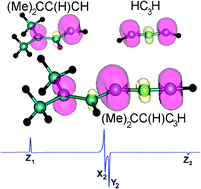Matrix isolation ESR spectroscopy and quantum chemical calculations on 5-methylhexa-1,2,4-triene-1,3-diyl, a highly delocalized triplet “hybrid” carbene†
Abstract
The

* Corresponding authors
a
Institute of Problems of Chemical Physics of the Russian Academy of Sciences, 142432 Chernogolovka, Moscow Region, Russian Federation
E-mail:
misochko@icp.ac.ru
b N. D. Zelinsky Institute of Organic Chemistry, Russian Academy of Sciences, 119991 Moscow, Leninsky prospekt 47, Russian Federation
The

 Please wait while we load your content...
Something went wrong. Try again?
Please wait while we load your content...
Something went wrong. Try again?
E. Ya. Misochko, A. V. Akimov, D. V. Korchagin, A. A. Masitov and K. N. Shavrin, Phys. Chem. Chem. Phys., 2012, 14, 2032 DOI: 10.1039/C2CP22853J
To request permission to reproduce material from this article, please go to the Copyright Clearance Center request page.
If you are an author contributing to an RSC publication, you do not need to request permission provided correct acknowledgement is given.
If you are the author of this article, you do not need to request permission to reproduce figures and diagrams provided correct acknowledgement is given. If you want to reproduce the whole article in a third-party publication (excluding your thesis/dissertation for which permission is not required) please go to the Copyright Clearance Center request page.
Read more about how to correctly acknowledge RSC content.
 Fetching data from CrossRef.
Fetching data from CrossRef.
This may take some time to load.
Loading related content
